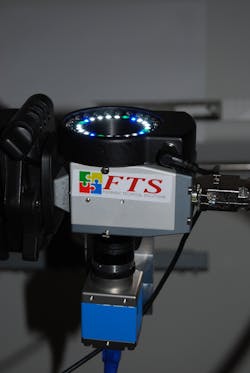African sleeping sickness, or trypanosomiasis, kills 30,000 people every year, in addition to entire herds of buffalo and cattle. Current treatments are ineffective or dangerous—but a fast, high-sensitivity camera is helping biologists at the University of Würzburg (Germany) search for better approaches.
Earlier research showed that trypanosomes, which are responsible for the disease, live in their host's blood. Using corkscrew-like movements, they swim incessantly, and always in the same direction. But why do they not succumb to the large numbers of antibodies that attack them? And why do they swim constantly, always in the same direction, apparently with no destination? These questions were the starting point for a research team headed by Markus Engstler, chairman of the University's Department of Cell and Developmental Biology. In 2007, their work led to a hypothesis that caused a sensation among experts.
The hypothesis was as simple as it was provocative—the pathogens consume the antibodies. According to this theory, the constant swimming has a purpose: It pushes the antibodies in the direction of the cell end. The motion creates a current that spreads over the smooth surfaces of the protozoans. Antibodies adhering to the surface offer resistance to the current and are pushed back in the direction of the cell mouth, where they disappear and lose communication with the immune system.
The results were initially called into question by American scientists in 2009, a move that launched cooperation between the research team and camera manufacturer PCO AG (Kelheim, Germany). With the help of the fast, sensitive pco.edge scientific CMOS (sCMOS) camera, the biologists analyzed the swimming behavior of the flagellates more closely—not only to substantiate their hypothesis, but also with hopes of finding a new therapeutic approach focused on pathogen motility.
To minimize external influence, they marked the cell membrane with a fluorescent dye and used the camera to observe the trypanosomes in a fluid environment on the specimen slide of an inverse digital microscope. Able to image at 400 frames/s, the camera made it possible for the first time to create high-resolution image sequences of the self-propulsion of the trypanosomes, whose flagella beat 20 to 30 times a second.
The images confirm the 2007 hypothesis that the parasites literally swim for their lives. The next step is to use this information to develop a suitable therapy. The goal will be to either slow the trypanosomes or make them swim backward, and thus prevent elimination of the antibodies. To this end, the researchers are now searching for genes that subdue motion. Systematic, large-scale genetic analyses identify the cells involved in the swimming movement, while the camera measures the change in swimming behavior. Through systematic screening of substance libraries, the researchers will then attempt to make the same changes. This approach makes it possible to identify lead compounds in combination with mechanisms of action.
It has already been shown that this principle works. By creating a special RNA in the pathogen, the researchers—under the supervision of Markus Engstler—were able to reverse the motion of the trypanosomes. The result: The pathogens swam backwards and the human antibodies were confronted with the front end of the pathogens instead of the cell mouth. Since the antibodies were not consumed, they were able to disable the trypanosomes.
"The short time intervals between consecutive images of a series make it possible to determine exactly how these flagellates move in three-dimensional space," said Engstler, who has cooperated with PCO on past projects. "The light signals correspond at the brightest areas to about 100 photons, which of course is a very weak signal." After working with a beta version of the camera, his department purchased a commercial version. "We would not have been able to record these images with a rival product," he noted.
Currently, the fast, high-sensitivity cameras are being used on infected animals in Nairobi. "We are trying to re-examine the results obtained in the ivory tower," Engstler explains. The main focus is on finding a medication against trypanosomiasis that has no side effects. "African sleeping sickness is a disease of the poorest people in the world and our results will certainly not be of interest to the major drug manufacturers," says Engstler. Migration and expulsion has ensured that the disease constantly and unexpectedly flares up at new locations; the target group is economically uninteresting for global pharmaceutical corporations. "Doctors without Borders" and other non-profit organizations have emphasized the need for more research in the field of sleeping sickness, and the researchers in Würzburg and their partner lab in Africa receive additional report from the German Research Institute (DFG).

